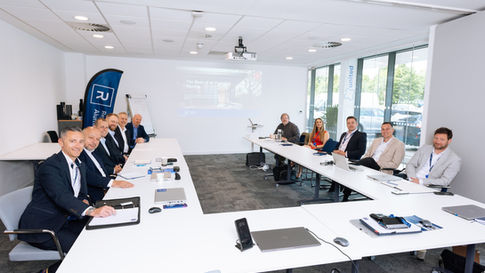Zentia explores the critical role antimicrobial coatings can play in preventing hospital-acquired infections (HAIs), highlighting their effectiveness and importance in maintaining a safe healthcare environment.
Hospital-acquired infections (HAIs) are infections that people can contract while receiving care for other conditions in healthcare facilities such as hospitals or clinics. These infections can result from various medical procedures or simply from being in a healthcare environment.
Bacteria such as MRSA (methicillin-resistant Staphylococcus aureus) and C. difficile (Clostridium difficile) are common causes of HAIs. These infections can spread within healthcare settings, posing risks to patients, staff, and visitors. To help mitigate these risks, antimicrobial coatings are often used to maintain a cleaner and safer environment.

Antimicrobial coatings are specialised treatments designed to inhibit the growth of harmful microorganisms such as bacteria, fungi, and viruses on surfaces. These coatings are especially valuable in high-traffic areas where maintaining strict cleanliness is essential, like hospitals and laboratories. By preventing the spread of microbes, they contribute to creating safer and more hygienic environments.
Biobloc Acoustic Antimicrobial Coating
Zentia’s Biobloc Acoustic ceiling tiles feature a highly effective antimicrobial coating, making them ideal for healthcare settings where infection control is a priority. This coating actively inhibits the growth of harmful microorganisms, including methicillin-resistant Staphylococcus aureus (MRSA), Escherichia coli (E. coli), and Aspergillus brasiliensis.
Biobloc Acoustic complies with the NF S 90-351:2013 microbiological classification M1 and the most onerous risk Zone 4. The ≤1 colony forming unit per m³ air M1 results were achieved in tests with:
Methicillin Resistant Staphylococcus Aureus (MRSA)
Escherichia coli (E-coli)
Bacillus cereus
Acinetobacter baumannii
Klebsiella pneumoniae
Streptococcus pneumoniae
Candida albicans
<1 was achieved for Aspergillus brasiliensis (Fungus) tests
This makes Biobloc Acoustic tiles suitable for even higher-risk healthcare environments, providing reliable protection against a wide range of microbial threats. At Queen Elizabeth University Hospital in Glasgow, for example, Biobloc Acoustic ceiling tiles were installed across 110,000m² of ceiling in the building, because their antimicrobial properties made them ideal for high-risk infection areas. The tiles are easy to clean and resistant to disinfectants, ensuring durability in busy hospital environments. Additionally, their sound-absorbing qualities help to create a quieter atmosphere, contributing to a more comfortable setting for both patients and staff.
How effective is Biobloc in reducing HAIs?
While Biobloc Acoustic ceiling tiles have a coating that helps prevent the growth of micro-organisms, they are meant to support, rather than replace, existing infection control practices.
This coating adds an extra layer of protection, but regular cleaning and disinfection should still be part of the infection control routine. Using Biobloc Acoustic tiles can enhance overall efforts to maintain a cleaner and safer environment in healthcare settings.
Integrating antimicrobial coatings, such as those in Biobloc Acoustic ceiling tiles, offers additional support to infection control measures in healthcare settings. These coatings help to maintain a cleaner environment, supporting wider efforts to reduce the risk of hospital-acquired infections.
The Biobloc Acoustic product was previously known as Bioguard Acoustic. Although the name has changed, the product is now made in the UK and its specifications and features remain the same or improved. Biobloc Acoustic achieves ISO 4 to ISO 14644-1:2015 standard and CP(0,5)5 to NF S 90-351:2013.

Ceiling tiles lend support to Stroke Unit
Construction has recently finished on a new Hyper-Acute Stroke Unit at Maidstone Hospital, part of the Maidstone and Tunbridge Wells NHS Trust. It will now form one of three specialist Hyper-Acute Stroke Units in Kent and Medway. The refurbishment works, which provided extended bed facilities and upgraded support spaces, were carried out in a ‘live’ hospital environment, with a busy corridor running through the middle of the works area. This meant the ceiling solution needed to be installed promptly and with ease to minimise any disruption.
Project architect Hazel McCormack Young and main contractors WW Martin needed an interior ceiling solution that could support patients’ health and wellbeing while also delivering a clean, white and fresh aesthetic fitting for a hospital environment. A suitable ceiling tile was also required for the shower rooms – an environment that is high in heat and moisture.
Zentia’s Biobloc and Hydrobloc ranges formed an effective solution for Maidstone Hospital, not only providing a modern and bright white ceiling but offering enhanced performance in hygiene, longevity and acoustics.
A total of 2,500m2 of white Biobloc Plain was installed in the main patient areas throughout the ward. The Biobloc Plain ceiling tiles are designed especially for use in healthcare environments, with a specialised biocide coating that inhibits the growth of bacteria. Easily disinfected, they also help to support health and wellbeing with high light reflectance and a sound attenuation level of 35dB.
Zentia’s Hydrobloc ceiling tiles were used in the ward’s shower rooms, a specialist tile that is designed to function in high humidity areas. Also high in light reflectance, they are rated Class A in sound absorption and remain stable in temporary conditions of up to 100% Relative Humidity (RH).
The tiles were installed by KRS Interiors, a member of Zentia’s award-winning Pinnacle Partner Scheme, meaning that they were able to access off-cut recycling through Zentia, minimising waste and enhancing the project's sustainability credentials.
The successful installation of Zentia’s complete ceiling solutions at Maidstone’s Stroke Unit reflects a balanced blend of functionality, hygiene, and sustainability in healthcare design. Thanks to the ease of installation with Zentia’s ceiling systems, the hospital was able to continue delivering vital care during construction, ensuring people are supported when they need it the most.
.png)








































.png)










